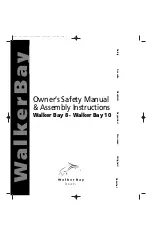
4F4: AC Shore Power Connect
The large “GEN - OFF - SHORE 1 - SHORE 2" switch on the AC
Power Supply panel are used to determine the source of AC power for
the boat. The “Shore Power” switch should always be “OFF” whenever
you are connecting or disconnecting the boat to shore. This is true so
that you do not draw an arc from the plug due to the load of the boat on
the connector’s pins: such an arc will burn the contacts and eventually
cause them to overheat when in use, creating a fire hazard.
The switch determines
which
shore power outlet you’re using: “1"
is Forward, “2" is Aft. Select the one you’re using by the switch.
Once connected to shore power, monitor the AC voltmeter and
ammeter to be sure you have not overloaded the circuit.
Important Note: If the house batteries are low
when you first hook up to shore power, and the
inverter is turned on (as it should be), the
inverter will begin charging its batteries at a
very high charging rate (up to 125 amps of
charging), drawing a lot of shore power current.
Until this demand reduces (see “AC Inverter
System” above), you should turn “OFF” other
high-current AC appliances such as the water
heater.
You can then turn on AC appliances as needed. Watch the ammeter to be sure you
don't exceed the dock's available supply, typically 30 amps.
Here are some estimates of typical AC power consumption for various appliances:
Water Heater
15 amps
Inverter
up to 30 amps
Hair Dryer
12 amps
TV
1.5 amps
Coffee maker
10 amps
Microwave
12 amps
Toaster
12 amps
Washer/Dryer up to 20 amps
If you overload the shore power connections, you may trip the dock breakers, or the
boat’s own breakers on the left of the switch.
4F5: AC Shore Power Reverse Polarity
Although we tend to think of AC Electricity as having only two conductors, it actually has
three
. One of these is called “neutral”; one is “hot”; and one is “ground”, that is, it is supposed
to be the same as the water around the boat and the earth ashore.
The vessel and many of its appliances rely upon these connections having the correct
“polarity”, or relationship to one another and the earth; this is essential to be sure that users of
AC equipment do not get a shock when touching and AC equipment.
Now in a house ashore, it’s easy: We don’t “plug in” the house, for it
stays connected to
the utility company all the time!
But in a boat when in the harbor, we do plug in using our
Shore Power cords (and sometimes using extension cords). If the outlet to which we plug our
cord, or if the cord itself is mis-wired, then these connections can become mixed up, and then
Shore power/generator
selection is made on the AC
Power Supply panel.
Section 4F: Electrical Systems, AC 4.11
















































